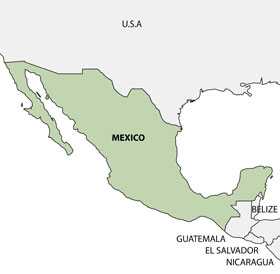Pertussis in Mexico
Español: Tosferina en México
On this Page

Overview
In November 2010, CDC-Latin American Pertussis Project conducted an initial assessment of the pertussis surveillance system and laboratory capacity in Mexico. Mexico’s Ministry of Health uses a standardized data collection form and case definition for pertussis (known as tos ferina). The national reference laboratory, Instituto de Diagnóstico y Referencia Epidemiológicos (in Spanish), and regional laboratories have laboratory diagnostic capacity in culture, real-time polymerase chain reaction (PCR), and serology. The national reference laboratory implemented real-time PCR in 2011 and regional laboratories in during 2012–2013. Both culture and real-time PCR are the primary pertussis diagnostics used in Mexico.
Case Definition
The case definition for probable cases of pertussis for all age groups is:
- Cough for 14 days or more and at least two of the following characteristics:
- Paroxysmal cough
- Inspiratory cough
- Spasmodic cough
- Cough followed by inspiratory laryngeal stridor or inspiratory whoop
- AND at least one of the following symptoms:
- Cough causing cyanosis
- Posttussive vomiting
- Episodes of apnea or cyanosis
- Evidence of bleeding (conjunctival, petechaie, epistaxis)
- Leukocytosis (more than 20,000 WBC) with predominance of lymphocytes (60-80%)
- Fever
- Contact with someone with similar symptoms in the past 2 – 4 weeks prior to start of illness
Note: Children under 3 months old can present with cyanosis with or without apnea, with or without cough.
Pertussis cases are confirmed if they meet the case definition, and have positive laboratory confirmation (by culture, real-time PCR, or serology), or are linked epidemiologically to a laboratory-confirmed case, or, if a laboratory sample is not available, by clinical criteria, as specified in the Manual for Epidemiologic Surveillance of Vaccine Preventable Diseases [6.72 MB, 276 pages] (in Spanish).
Vaccine Abbreviations
- DTP – Diphtheria and tetanus toxoids and whole cell pertussis vaccine
- DTaP – Diphtheria and tetanus toxoids and acellular pertussis vaccine
- Tdap – Tetanus toxoid, reduced diphtheria toxoid and acellular pertussis vaccine
- HB – Hepatitis B vaccine
- Hib – Haemophilus influenzae serotype b vaccine
- IPV – Inactivated polio virus vaccine
Immunization Program
Mexico’s routine pertussis immunization program includes a pentavalent vaccine, which contains DTaP (acellular pertussis component), IPV, and Hib, administered at 2, 4, and 6 months, and a booster at 18 months. Mexico’s Ministry of Health recommends a dose of DTP vaccine (whole cell pertussis component) at 4 years of age. They also recommended Tdap for all pregnant women at 20 through 32 weeks gestation since 2012.
View Mexico’s complete vaccination schedule (in Spanish).
Related Pages
- Mexico’s guidelines for epidemiologic surveillance (in Spanish)
- Mexico’s 2017 laboratory guidelines for epidemiologic surveillance of pertussis and coqueluchoide syndrome [1.84 MB, 111 pages] (in Spanish)
- Mexico’s weekly bulletins from the national system of epidemiologic surveillance (available from 1981-2016) (in Spanish) (in Spanish)
- Page last reviewed: August 7, 2017
- Page last updated: August 7, 2017
- Content source:


 ShareCompartir
ShareCompartir